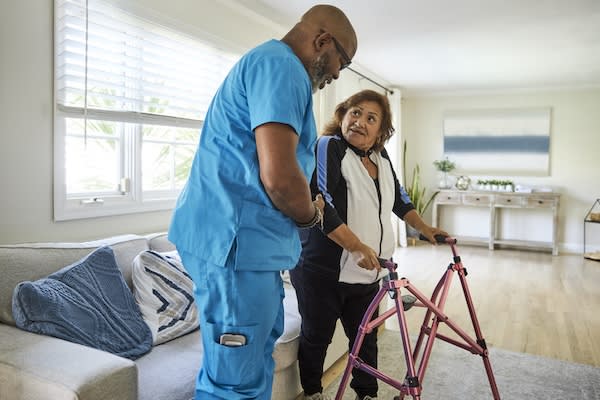Myasthenia gravis vs. ALS: Symptoms, causes and treatment

[5 MIN READ]
In this article:
- Amyotrophic lateral sclerosis (ALS) and myasthenia gravis (MG) share similar symptoms but are two different neurological conditions.
- ALS is a terminal disease, but there are ways to help manage symptoms associated with it and improve your quality of life.
- MG is rarely fatal and several treatment options could lead to remission from the disease.
ALS vs. myasthenia gravis
Amyotrophic lateral sclerosis (ALS) and myasthenia gravis (MG) share many of the same symptoms including muscle weakness and difficulty swallowing. However, that’s where the similarities end.
“Because ALS and MG are neurologic disorders that affect people similarly, people often assume they are related,” says Providence Neurologist Tracy Bazan, M.D. “The truth is, they are very different conditions that affect people differently. ALS is a terminal illness while myasthenia gravis is treatable and can go into remission.”
Symptoms of myasthenia gravis and ALS
ALS and myasthenia gravis symptoms appear similar because the brain and muscles change and weaken in both conditions.
Shared symptoms of ALS and myasthenia gravis include:
- Muscle weakness
- Speech dysfunction
- Trouble swallowing
Symptoms specific to ALS include:
- Difficulty chewing
- Loss of muscle
- Muscle cramps
- Muscle weakness
- Trouble breathing
ALS causes muscles to weaken over time, including respiratory muscles which can lead to trouble breathing.
Symptoms specific to MG include:
- Eyelid drooping
- Facial drooping
- Impaired speech
- Shortness of breath
- Vision changes (blurry vision, double vision)
One of the biggest differences between ALS and myasthenia gravis is the prevalence of symptoms. “If you have myasthenia gravis, your symptoms will most likely improve with rest and may lessen throughout the day. ALS symptoms do not improve with rest,” Dr. Bazan says.
ALS tends to develop later in life and affects more men than women. MG is considered bimodal; it affects people earlier in life and later in life. Like many other autoimmune diseases, MG tends to affect more women than men.
What causes myasthenia gravis and ALS
The causes of ALS and myasthenia gravis are different. MG is considered an autoimmune disease, which means the immune system mistakes healthy cells as dangerous and attacks them. ALS is a motor neuron, a type of disease in which the motor neuron cells of the central nervous system stop working. Motor neuron disease worsens over time.
MG causes antibodies to block or destroy acetylcholine, which limits the brain’s ability to communicate with muscles. A problem with the thymus gland may also cause MG. The thymus gland generally shrinks after puberty, but people with MG still have large thymus glands. Since the thymus gland still produces immune cells, researchers believe it sends the wrong message to immune cells and causes them to attack bodily tissue.
MG also has symptoms similar symptoms to multiple sclerosis, which is another autoimmune disease. MS damages your myelin sheath which protects your nerve fibers. MG impacts your nerve and muscle cells.
Researchers are still trying to determine the cause of ALS. Gene mutations are thought to play a role in the development of the disorder. There is also some evidence that viral illness, physical trauma, poor diet and toxins could lead to ALS, but that has not been confirmed.
Another progressive neurological disorder similar to ALS is Parkinson's disease. However, Parkinson’s disease has more effect on cognition and gait.
Diagnosing myasthenia gravis and ALS
Because ALS and MG can appear similar, there is some overlap in the diagnosis process. Neurological exams are used as a baseline for both conditions. If your doctor suspects ALS or MG, some of the tests they may do include:
- Blood tests to look for elevated levels of antibodies that cause MG.
- Electromyography (EMG) to measure muscle response or electrical activity in response to nerve stimulation of the muscle.
- Magnetic resonance imaging (MRI) to rule out other abnormalities, such as tumors.
Tests done to diagnose MG include:
- Edrophonium test which is done by injecting a drug called tensilon after activity to see if muscle weakness improves.
- Pulmonary function test to check lung function.
A muscle biopsy might be done to help diagnose ALS by eliminating other conditions.
Dr. Bazan says there is no set diagnostic criteria for ALS. “The diagnosis of ALS is often a process of elimination and making sure that it’s not something else mimicking the disease. No blood test reveals a diagnosis of ALS,” Dr. Bazan says.
Treating and living with myasthenia gravis and ALS
The treatment for ALS and myasthenia gravis varies so it’s important to receive an accurate diagnosis before beginning a treatment plan. It’s also important to diagnose MG and ALS in the early stages for both conditions, when possible. Early intervention is key to managing symptoms and can also help to slow disease progression.
Several treatment options for myasthenia gravis can greatly improve the quality of life for those with the disease. In some cases, people with MG may go into remission and have no symptoms either permanently or temporarily.
Treatments for MG include:
- Acetylcholinesterase inhibitors to prevent the destruction of acetylcholinesterase so communication between the brain and muscles is not impacted.
- Immunosuppressants to help the immune system function properly so cells stop attacking acetylcholine receptors.
- Plasmapheresis, a procedure that uses a machine to remove damaged antibodies out of blood plasma and replace them with healthy ones.
- Thymectomy which removes the thymus gland.
“Because immunosuppressants can leave people susceptible to infection, I generally use those as a last resort,” Dr. Bazan says.
ALS is a terminal disease, which means there is no cure. The typical life expectancy for those with ALS from the time of diagnosis is two to five years. However, there are ways to improve the quality of life for those living with ALS.
Treatment for ALS includes:
- Medication to decrease neuron damage and slow down the progression of the disease.
- Physical therapy, which can help increase mobility.
- Speech therapy to improve verbal communication.
- Brain-computer interface (BCI), which allows a person with ALS to control a wheelchair and electronic voice with their brain activity so they can communicate without moving or speaking.
- Breathing support, including oxygen masks and breathing tubes to help people breathe.
“Receiving an ALS diagnosis can be overwhelming, but we are here to support the entire family. We use a multidisciplinary approach to treat our ALS patients. In one afternoon, we pull everyone together from neurology, palliative care, physical and speech therapy, and occupational therapy. We function as a team to help those living with ALS have the best quality of life possible,” Dr. Bazan says.
While there is no cure, Dr. Bazan stresses the importance of symptom management for ALS. She also urges her patients and their families to take advantage of support groups for those in similar situations.
Contributing caregiver

Tracy Bazan, M.D., is a neurologist with Providence Neurological Specialties – East.
Find a doctor
The Providence Neuroscience Institute offers access to one of the largest networks of specialty trained neuroscience physicians in the country. This collaborative system includes award-winning physicians, scientists, researchers and caregivers across 51 hospitals in seven states. The knowledge and skills of these professionals, combined with the expertise of your local team, mean you’re getting the best personalized care.
If you are looking for a Providence neurologist or primary care physician, you can search for one who’s right for you in our provider directory.
Download the Providence app
It’s all in the app: easily stay connected with Providence and your health. With the Providence app, you can schedule appointments, have virtual visits from the comfort of your own home, get health recommendations personalized for you, access your health records and so much more. Learn more and download the app.
Related resources
Helping ALS patients preserve their highest quality of life
Using robotic technology to improve outcomes in myasthenia gravis and thymoma
This information is not intended as a substitute for professional medical care. Always follow your health care professional’s instructions.



